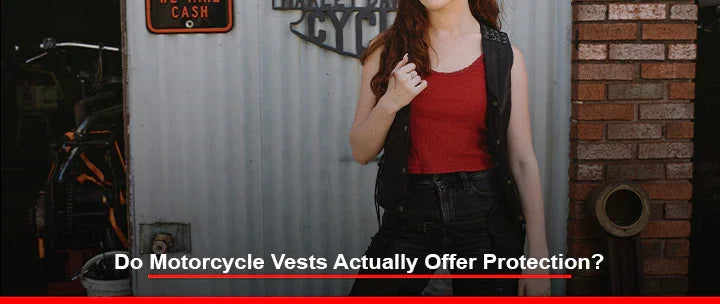Have you ever heard this phrase by someone that “Dress for the slide, not the ride.” But here the question arises: Does your motorcycle vest protection actually shield you in a critical moment?
Motorcycle riders make up 14% of all traffic fatalities, even though they are only involved in 3% of registered vehicles in the U.S., according to the motorcycle experts. Protective gear helps prevent serious injuries during crashes, but not all gear is created equal.
So, do motorcycle vests offer real protection, or are they just part of the biker look?
This article uncovers the truth about how much protection motorcycle vests really offer, looking at different types, their safety features, real-world crash performance, and expert opinions. Whether you're a daily rider or a weekend warrior, knowing what protects you could make all the difference.
Why Motorcycle Vest Protection Matters in a Crash?
In the crash, motorcyclers are often thrown from the bike in the crash, leaving their chest, back, and torso exposed to a hard hit that causes a severe impact and abrasion. Unlike cars, there is nothing around you to protect you. The initial hit is followed by sliding on the road, which causes damage to organs, breaks in bones or ribs, and life-threatening injuries.
Injuries to the chest and spine are among the leading causes of fatal outcomes, which is why protecting these areas matters just as much as wearing a helmet.
Do Motorcycle Vests Really Protect You in a Crash?
A motorcycle vest can contribute to safety, but it depends on its design. While a basic leather vest may reduce scrapes in a slide, an armored or airbag vest provides substantial protection during impact.
Key takeaway: Vests aren’t all equal. The protection they offer varies based on materials, construction, and built-in armor.
Different Types of Motorcycle Vests and Their Protection
Leather vests are popular for their classic biker aesthetic and basic abrasion resistance. However, they offer little to no impact protection and shouldn’t be relied on for serious crashes.
Armored Vests:
These vests include CE-rated armor inserts at the chest, back, and ribs. Designed for impact absorption, they’re used by serious riders and even professional racers.
Airbag Vests:
Airbag vests deploy in milliseconds during a crash, inflating around your upper body to prevent spinal injuries, broken ribs, and internal trauma. Studies show they reduce injury by up to 90% in controlled crash scenarios.
Textile vs. Leather:
High-density textiles like Cordura and Kevlar blends are often better than standard leather, offering superior abrasion resistance and the ability to integrate with armor more seamlessly.
Armor and Materials That Help Protect You
Armor Inserts
Vests with CE Level 1 or Level 2 rated inserts offer real impact protection. They reduce the force of the crash to stop serious damage and protect your chest and back. Riders seeking a biker protective vest should prioritize armor compatibility and proper fit for maximum effectiveness.
Materials Used
-
Leather: Traditional, durable, abrasion-resistant, but lacks impact defense.
-
High-Density Textiles: Lightweight, breathable, abrasion-resistant, often armor-compatible.
Key Safety Features in Protective Motorcycle Vests
Scraping Resistance
A vest can protect against road rash if it’s made of tough leather or abrasion-rated textiles. However, arms and shoulders remain exposed unless you wear a jacket.
Armor technologies
D3O, SAS-TEC, and Knox are popular armor technologies that absorb and disperse crash energy, protecting vital organs and the spine.
Vest Protection Levels
Look for vests rated EN 1621-1 or 1621-2.
-
Level 1: Basic protection
-
Level 2: Higher protection for track or high-speed riding
Back and Chest Protectors:
These reduce the risk of sternal fractures, spinal cord damage, and lung punctures, common in direct impacts.
Additional Considerations about Safety
Fit Matters:
A loose vest can shift during a crash, reducing protection. A snug fit ensures the armor stays in place on impact.
Layering with Other Gear:
Many riders wear vests over armored jackets for visibility or patches. However, some vests are designed to be worn under or instead of jackets.
Weather and Comfort:
Modern vests use ventilated mesh, moisture-wicking liners, and lightweight textiles to ensure you stay safe and cool on long rides.
How Motorcycle Vests Help Prevent Injuries
Scientific Studies & Experts' Findings
According to the experts, armored gear reduces upper-body injuries by 63% in controlled accident simulations. Another study from the Journal found that riders wearing armor had 45% fewer rib fractures.
Real-World Experiences
Many riders credit armored or airbag vests for walking away from high-speed crashes with minimal injuries. Testimonials from forums like ADVrider and r/motorcycles support this, showing consistent praise for CE-rated gear and airbag systems.
Common concerns about vest protection
False Sense of Security
Some critics argue that vests may encourage reckless riding. However, data shows protective gear actually reduces severity, not increases risk.
Limitations in High-Speed Collisions
Even the best vest can’t prevent all injuries in high-impact crashes. That’s why vests should be one part of a complete safety kit, including helmets, gloves, pants, and boots.
Future of Vest Technology
The Rise of Smart Vests
Smart airbag vests like Alpinestars Tech-Air and Dainese D-Air use inertial sensors and gyroscopes to detect crashes before contact, deploying in milliseconds.
Beyond the Physical: The Psychological Impact
Wearing protective gear builds confidence and helps riders focus, reducing fatigue and distractions on long rides.
How to Choose a Motorcycle Vest That Actually Protects
It depends on the vest.
| • Basic leather vests | Minimal protection. |
| • Armored textile vests | A smart middle ground. |
| • Airbag vests | Top-tier protection that could save your life |
If you ride regularly, especially at higher speeds, investing in an armored or airbag vest could make the difference between walking away and not.
Types of Leather Vests & Their Protection Level
| Vest Type | Abrasion Resistance | Impact Protection | Best Use |
|---|---|---|---|
| Leather Vest | Moderate | Low | Style, short rides |
| Armored Textile Vest | High | Medium-High | Daily or highway riding |
| Airbag Vest | High | Very High | Long-distance, high-speed |
Conclusion:
Motorcycle vests can provide protection, but their effectiveness depends on the type. Classic leather vests offer basic abrasion protection but lack impact defense, so they aren't suitable for serious crashes. Armored and airbag vests, however, offer substantial protection against both abrasions and impacts, making them essential for safety.
For everyday riders, armored textile vests strike a good balance, offering comfort, abrasion resistance, and impact protection. If you're riding at high speeds or long distances, an airbag vest can significantly reduce the risk of severe injuries.
No vest can guarantee complete safety, but combining it with other protective gear like helmets, gloves, and pants maximizes your protection. Choose a vest that fits well, has quality armor, and matches your riding needs. Safety isn’t just about style, it's about wearing the right gear that can save your life.
FAQs
1. Are motorcycle vests as protective as jackets?
Not quite. While some vests offer solid impact protection (especially armored or airbag vests), they don’t cover your arms and shoulders like jackets do. For full protection, many riders pair vests with armored jackets underneath.
2. What is the most protective type of motorcycle vest?
Airbag vests offer the highest level of protection. They deploy in milliseconds during a crash to protect the spine, chest, and vital organs. Armored textile vests with CE Level 2 inserts are also highly protective.
3. Are Leather Motorcycle Vests Safe for Riding?
Leather vests can provide some abrasion resistance during a slide, but they typically lack the impact protection needed in a serious crash. They're more about style and tradition unless combined with armor.
4. Is an armored vest better than a regular vest?
Yes. An armored vest includes padding or CE-certified inserts that help absorb crash impact, which regular vests don't offer. If you’re serious about safety, choose one with verified protection ratings.
5. What do CE Level 1 and Level 2 mean in motorcycle armor?
CE ratings measure how much energy the armor absorbs during an impact.
-
Level 1: Allows up to 18 kN of force (basic protection)
-
Level 2: Allows up to 9 kN of force (better for higher speeds and long rides)
6. Can I wear a vest over my motorcycle jacket?
Yes, especially if it's for visibility (like high-vis or club vests). But safety-wise, it’s better to wear a vest with integrated armor or one that complements your existing jacket’s protection.
7. Do airbag vests really work?
Yes. Studies and real-world testimonials show that airbag vests dramatically reduce injury severity. They’re commonly used in professional racing and are becoming more popular among everyday riders.
8. How do I know if a motorcycle vest is protective?
Look for these indicators:
-
CE-certified armor (Level 1 or 2)
-
Reinforced materials like Cordura®, Kevlar®, or Dyneema®
-
Snug fit with secure closures.
-
Reputable brands with crash-tested gear








